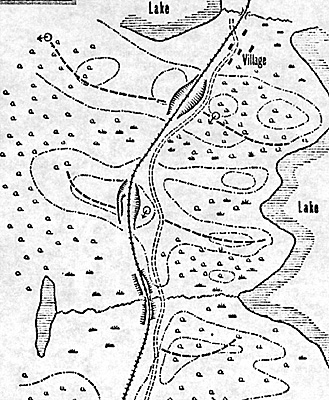In April 1919, No.1 Special Company of the Kings Royal Rifle Corps arrived in Murmansk to join General Maynard`s polygot Syren Force. Commanded by Major V. Yeats-Brown, No.1 Special Company consisted of three platoons of the KRRC and one from the Rifle Brigade, mustered at short notice on 6th April before being immediately shipped to Russia. In all there were 7 officers and 212 ORs, most of whom were veterans of the Western Front.
On 1st May, General Maynard began a three pronged offensive against Red Army strongholds. The Central Column under the Canadian, Colonel Leckie, began it`s advance down the Archangel-Vologda Railroad on 7th May, rolling up Red positions in it`s path.
On the 15th May, The KRRC were spearheading the column and had advanced a few miles beyond Siding 13 when they ran into a series of strongly-defended Red positions, dug in on low hills overlooking a small village on the main line.
No.1 Platoon led by Lt.Allhusen immediately summed up the situation and began to close with the first enemy position to the right of the track., whilst No.2 platoon under Lt. Jervis attempted to enfilade the position with rifle and Lewis gun fire from the left. However, well executed, the attack began to stall against the well prepared Red entrenchments.
At this point Major Yeats-Brown dashed forward and across the railway line, under heavy rifle fire. He ordered No.1 platoon to fix bayonets and led them in a wild charge towards the Bolshevik positions. This sight was enough for the Reds and they bolted, many being shot down as they ran.
No.3 Platoon under Lt. Gurney, had been working it`s way forward on the left whilst No.1 & 2 platoons were engaged. As the platoon approached a low rocky ridge, it came under withering machine-gun fire, effectively pinning it down.
Flanking Movement
With the Reds cleared from the first position, Major Yeats-Brown now led No.s 2 and 4 Platoons in a left flanking movement which brought the Red machine-gun under accurate enfilade fire from Corporal Fisher`s Lewis gun. In a few minutes the Reds were on the run once again.
400 yards away lay the final Red position defended by two machine-guns on a long wooded ridge. No.s 1 & 3 Platoons (Lt. de Salis), moved forward to a small knollon the right and brought accurate small-arms and Lewis gun fire to bear on the Red entrenchments. Major Yeats-Brown was once again at the forefront of the action, leading the remaining platoons against the enemy`s right in an attempt to roll up his defence.
As No.s 2 & 4 Platoons reached the crest of the hill, Lt Allhusen led No.1 Platoon forward under the covering fire from Lt. de Salis`s men. It was too much for the Reds who broke and fled in disorder to the rear, allowing the Rifles to take the village.
The Middlesex Company which had been in support, now pushed on to harass the retreating Bolsheviks and engage their rearguard which included an armoured train.
The action lasted about two hours. British casualties amounting to two officers and eight ORs wounded, against over forty Bolsheviks killed. The collection of wooden log huts occupied by the Rifles at the end of the action was named 60th Village in honour of their performance.
BRITISH FORCES
No. 1 Special Company, Kings Royal Rifle Regiment
1 CO Major Yeats-Brown (Heroic Leader)
4 Platoons each:
1 Officer,
14 riflemen,
1 Lewis gunner (3xD6) +1 bonus for being Veterans
BOLSHEVIK FORCES
1CO
2 Companies each:
1 Officer/Commissar
3 Platoons: 16 riflemen
2 Machineguns with 2 man crews (6xD6)
1 Colt Machinegun with 1 man crew (3xD6)
From : AT WAR WITH THE BOLSHEVIKS Robert Jackson, Tandem Books, 1972

Back to The Gauntlet No. 13 Table of Contents
Back to The Gauntlet List of Issues
Back to Master Magazine List
© Copyright 1998 by Craig Martelle Publications
This article appears in MagWeb (Magazine Web) on the Internet World Wide Web.
Other military history articles and gaming articles are available at http://www.magweb.com